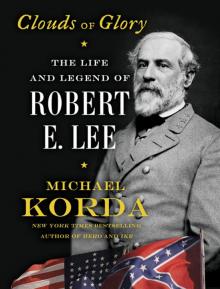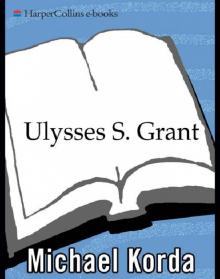- Home
- Michael Korda
Clouds of Glory Page 43
Clouds of Glory Read online
Page 43
Stuart set off in his trademark finery—a plumed hat, a scarlet-lined cape, “a tasseled yellow sash,” and buckskin gauntlets. He led his troopers north at a brisk pace, then crossed the Richmond, Fredericksburg, and Potomac railway line in the direction of Louisa Court House, fifty-eight miles away. He hoped that Federal spies would think he was riding to join Jackson in the Valley. The fine, sandy roads were dry, and the sun was shining—another worry for Lee, who feared that good weather and drying roads would enable McClellan to bring his heavy guns forward and start shelling Richmond. They bivouacked for the night on the farm of a Confederate supporter, giving Stuart and Rooney Lee a chance to spend a few hours at Hickory Hill and visit Rooney’s wife, Charlotte. Then the next day they turned east and made a circle around Hanover Court House.
By now the Federal cavalry had spotted Stuart’s group and were in hot pursuit, and much of June 13 was spent in fierce hand-to-hand clashes with Union cavalry units. The following morning Stuart pressed on to Old Church, seventeen miles from Hanover Court House, at which point he could, with honor, have turned back. He had already learned what Lee most wanted to know: McClellan had no fortified line north of Beaver Dam Creek toward Hanover Court House, the direction in which Jackson’s army would attack, and only small numbers of troops. It seems amazing that the presence of 1,200 Confederate cavalry troopers well behind his own lines did not arouse McClellan’s suspicion that Lee might be about to attack him there, but given Stuart’s flamboyant reputation, he may have considered it just a stunt.
Stuart had broached the idea of riding around the Union army to Lee, who had cautioned against it, but now that he was east of Old Church Stuart decided it would be safer and more interesting to go on than to return the way he had come, which was now swarming with Union cavalry. He pressed on to Tunstall’s Station, not five miles from the house from which Mary Lee had been evicted by the arrival of the Federal army; shot up a train; destroyed the tracks; pulled down telegraph poles; and rode on to Talleysville, where his men rested for a few hours, then saddled their horses and rode south toward the Chickahominy. After covering forty miles that day his men were so exhausted that they fell asleep in the saddle, but they rode on by moonlight to the Chickahominy, only to find that the bridge there had been destroyed. Stuart paused to build a plank bridge using an upturned skiff as a pontoon—another demonstration of his genius for mounted warfare. Once across the river, they burned the bridge they had jerry-rigged behind them; they were safe now from the pursuing Federal cavalry, which, typically of the Civil War, was led by Stuart’s own father-in-law. Stuart then rode on himself from Charles City Court House and covered the thirty miles from there to Richmond in less than nine hours. Afterward, he rode out to meet the main body of his men as they entered the city. By midmorning Stuart’s exploit had already made him a southern hero second only to Stonewall Jackson. As they paraded through the city he and his men were greeted by girls throwing flowers—even Stuart’s horse was decorated with a garland of flowers around its neck. Stuart not only had relieved the city’s inhabitants of the fear that they were cut off but also had covered nearly 100 miles in three days, burned stores of supplies valued at over $7 million, and brought home 165 prisoners and 260 horses and mules. The fact that his men had ridden right around 100,000 Union soldiers made the Federal army on the peninsula look foolish as well as inept.*
More important, he had brought exactly the information Lee wanted. There was nothing north of McClellan’s right to stop Jackson from flanking him there, at the same time cutting off his two supply lines, the railway, and the wagon trail from West Point and White House. Though Jackson was still asking for his strength to be increased to 40,000 men so he could invade the North, Lee had already decided against this. When he met with Colonel Boteler of Jackson’s staff on June 14, having learned from Stuart that there was nothing to stop an attack to the north of Beaver Dam Creek, he hinted that Jackson would have to march east, not north. When the colonel pointed out that Jackson’s men were used to mountain air and would die of disease in the pestilential swamps around the Chickahominy, Lee replied, “That will depend on the time they will have to stay here.”
Clearly, what Lee had in mind was for Jackson to make a crushing blow against McClellan’s right, followed by a swift return to the Valley. Boteler sounds a mite skeptical in his conversation with Lee—or as skeptical as a colonel can be when talking to a full general—but then he knew Jackson better than Lee did. General Longstreet, when Lee discussed his plans with him, seems to have been even more skeptical. It would be Longstreet’s fate to play the role of a doubting Thomas for three years, but Lee did not hold it against him. Despite his calm demeanor, Lee approached all his battles with the utmost zeal and conviction. A slow, stubborn, grumbling skeptic, provided exactly the balance that Lee needed to temper his own natural optimism. He recognized that “Old Pete,” as Longstreet was known, was a first-rate professional soldier. Today Lee’s defenders are generally more critical of Longstreet than Lee himself ever was.
On June 16, having learned from Stuart what the ground was like north of the Chickahominy, and how muddy the roads still were, Lee rode out to view the Union lines for himself. Turning to A. L. Long, the aide who accompanied him, he said, “Now, Colonel Long, how are we to get at those people?” Probably, Lee was speaking to himself rhetorically and neither wanted nor expected to hear Colonel Long’s opinion, but it is interesting to note that he was already in the habit of calling the enemy “those people.” Some writers have assumed that this was a sign of contempt, but it would have been unlike Lee to harbor any such feeling. It seems far more probable that he simply could not bring himself to call the enemy “the United States Army.” The men in front of him were wearing the blue uniform that had been his for thirty-five years, even though he now wore the gray uniform of the Confederate Army. Despite Lee’s rhetorical question to Long, he had already decided exactly what he was going to do. He explained his plans in detail to President Davis, who was concerned that Richmond would be virtually uncovered as Lee concentrated his forces. It was a risk Lee was willing to take. Jackson, following Lee’s instructions, was disengaging his troops in the Valley and dropped out of sight himself. Once Jackson arrived north of the Chickahominy, Major General D. H. Hill and Major General Longstreet would cross the Chickahominy and join him at Mechanicsville. This would give Lee 65,500 men against approximately 30,000 Federal troops of Brigadier General Fitz John Porter, while Major General A. P. Hill held the Union forces entrenched behind Beaver Dam Creek in place until they had been turned by Jackson’s advance. In the meantime, 21,000 Confederate troops would hold the entrenchments around Richmond against the remaining 60,000 Federal troops dug in facing that city. Lee anticipated that Jackson, Longstreet, and D. H. Hill would then sweep forward, driving Porter’s troops back and threatening to cut McClellan’s lines of communication to White House and West Point, taking New Bridge, about six miles east of Mechanicsville, on the way. Lee could then move his troops north or south of the Chickahominy depending on how the situation developed. Cut off from their supply lines, McClellan’s forces would have no option but to retreat. It might even be possible to attack them in the flank as they did so, bringing about the disintegration, if not the destruction, of the Army of the Potomac.
A glance at the map will show that this was an ambitious concept. Beyond the risks that Davis and Longstreet had pointed out to Lee, there was the question of how he could command a coordinated action over a front that extended almost fifteen miles from just south of Seven Pines (where the Federal left ended) to Totopotomoy Creek, just north of Mechanicsville, which was where Jackson’s columns were to deploy.
For a man who had never commanded an army of this size in the field, Lee was taking on a formidable task. Granted, he knew McClellan well enough to guess that his reaction would be slow and cautious. But Lee could still have had no idea that McClellan believed he was facing an army more than twice the size of his own, when in fact Lee had
just over half the number of troops McClellan had. In fact McClellan was still accusing the president of betraying him by withholding reinforcements: “Honest A has again fallen into the hands of my enemies,” he wrote to his wife, Ellen, and he predicted to her that he would pin Lee down “in his lines around Richmond.” He promised her, “I will then have them in the hollow of my hand,” and he was even confident enough to write to Lincoln, offering “to send the president his views ‘as to the present state of military affairs throughout the whole country,’” adding his opinion that a negotiated peace with the Confederacy might be obtained by guaranteeing the right of slave owners to their property.
Lee was by now anxious to meet with Jackson “at some point on [his] approach to the Chickahominy.” On June 19, having set his army in motion, Jackson made haste to Gordonsville, which he reached on Sunday, June 22, with his 18,500 troops and his artillery spread out behind him, on foot, in relays of freight trains, and in wagons. Jackson spent that day and evening in the village of Fredericks Hall—he would not travel or transact business on the Sabbath—and left at one o’clock in the morning on the first of a series of “commandeered” horses, accompanied by three of his staff. He wore no badges indicating his rank, and traveled with a pass made out “for an unidentified colonel.” He covered the fifty-two miles between Fredericks Hall and Richmond in just fourteen hours, changing horses at intervals, but taking no rest himself. In the mid-afternoon on Monday, June 23, members of Lee’s staff were surprised to see a dusty, shabby, visibly exhausted horseman, the peak of his crushed, battered kepi pulled low over his face, dismount “stiffly” in the yard of the Widow Dabbs’s house just off Nine Mile Road, near Richmond, where Lee had established his headquarters. On being told that General Lee was at work, the dusty horseman, who had declined to identify himself, slouched against the fence until General D. H. Hill, rode up and to his surprise recognized his brother-in-law Jackson, who he had supposed was still in the Valley. Hill shepherded Jackson into the house, where Lee at once appeared and offered him “refreshment,” though Jackson accepted only a glass of milk.
Lee had called together his commanders for the forthcoming attack against McClellan: Jackson, D. H. Hill, Longstreet, and A. P. Hill. The oldest were Longstreet and D. H. Hill, both forty-one; Jackson was thirty-eight; A. P. Hill was thirty-seven—all four comparatively young for their rank and responsibilities. It was a “historic” meeting, not only because of the battle to come, but because it was a significant turning point in the war. Up until now, the South had for the most part fought a defensive war, reacting to Federal attacks on southern soil. Now, although Lee was not yet ready to “invade” the North, he was determined to fight an offensive war, subjecting a larger army to continual attack. Even Lee could not have imagined he would fight ten battles in just one week.
As for his four major generals, they were very different personalities, and not without some trace of the usual human flaws, among them competitiveness, rivalry, personal ambition, and a stubborn belief on the part of each that he knew best. Like Lee, Longstreet, A. P. Hill, and D. H. Hill admired Jackson, who was the hero of the hour owing to his victories in the Valley, but found him awkward, uncommunicative, and showing no apparent “mark of genius.”
It may be that Jackson was already exhausted by the effort of moving his army east, but it is also possible that his personality simply did not lend itself to a council of war of equals. Only a month earlier, he had decided, in disgust, never to hold another council of war in his own army, and he probably did not like this one any better. He was willing to subordinate himself to Lee, but he was not a team player. By nature a loner, Jackson did not share his plans even with his closest subordinates—a habit that could sometimes backfire on him. He could be very kind, and he had a certain grim sense of humor, but he was an exceptionally harsh disciplinarian, and his soldiers were awed by him rather than fond of him. When one of his officers remarked, of a doomed Federal charge, what a pity it had been to shoot down so many brave men, Jackson replied, “I don’t want them brave, I want them dead.” When another protested that if he followed Jackson’s order his men would be annihilated, Jackson replied sternly, “I always endeavor to take care of my wounded and bury my dead. Obey that order, sir.”
Jackson’s admiration for Lee was such that he would say, “So great is my confidence in General Lee that I am willing to follow him blindfolded.” Unlike Longstreet, who would, to the end, resist following Lee blindfolded, Jackson was never troubled by any doubts about Lee’s judgment.
Lee then did a curious thing. Having described his battle plan he left the room—we do not know for how long—so that the four generals could discuss it without his presence. He may have felt that they could speak more frankly in his absence, or that as experienced professional soldiers they could work out the details for themselves. Whatever he intended, it was a mistake, certainly so far as Jackson was concerned. Lee’s plan hinged on Jackson’s prompt arrival and attack, but whether Jackson understood that is open to question. Jackson’s troops had the farthest distance to travel, so it was logical that the moment he arrived to flank General Porter’s lines on Beaver Dam Creek would be the signal for the other three generals to advance. Exact timing was therefore crucial. When asked when his army would be in position to attack, Jackson is said to have “mumbled” June 25: that is, in two days’ time. Typically, it was Longstreet, always the pessimist, who questioned this date and suggested that Jackson give himself an extra twenty-four hours. At that, the conference drew to a close and Lee returned: the attack would begin at three in the afternoon on June 26.
It seems a pity that Jackson had left his gifted cartographer Captain Jedediah Hotchkiss behind in the Valley. Nobody at the conference in the parlor of the Dabbs house appears to have had an altogether clear picture of the ground ahead—and no two of those present had the same picture—while Jackson seriously underestimated the difficulties crossing the country between Fredericks Hall and Totopotomoy Creek even though he had just ridden over it himself.
Jackson then set off—without a rest—to the vanguard of his army, a thirty-mile ride, much of it in the dark and in pouring rain. What he found when he got there should have alarmed him. His inability to delegate or share his plans had led to delay and to large numbers of stragglers, that is to say, men who fell far behind their units (always a serious problem in the Civil War on both sides). Some of his regiments were moving by train, others slogging along muddy roads. Nobody seemed to be in command, and the army was spread out over fifteen miles with no one person urging it forward. The presence of Jackson, with his grim Old Testament face, by the side of the road mounted on Little Sorrel, urging his men to “Press on, press on,” was one element that had made it possible for his army to perform miracles, but he was apparently in no mood, or shape, to perform a miracle on June 24. Hardly anything in warfare is more important or demanding than a general’s ability to keep his men together and moving to a demanding schedule under difficult conditions, and by this test Jackson failed between June 24 and 26. Jackson’s biographers ascribe this to exhaustion, and that was surely a factor; but it is one of a general’s duties to keep himself alert and rested, even at the risk of appearing self-indulgent to his critics, and another, scarcely less important, is to delegate authority so that he is not always obliged to be sorting out traffic jams, or searching for the right road.*
Military historians also criticize Lee for not drawing up his plans clearly enough, for tolerating poor staff work, and for overrelying on his corps commanders. In short, Jackson did not delegate enough and Lee delegated too much. There is some truth to this, but the reality is that the first of the “Seven Days” of battle on the peninsula was a painful learning experience—Lee had never commanded an army of this size before, and Jackson had never served as a critical part of a much larger army. What matters more is that when the first day of battle began General McClellan was within seven miles of Richmond, waiting for the roads to dry to bring up his
siege train and start the bombardment of the city, and a week later he and his army had been driven into a small “pocket” on the James River under the protection of Union gunboats, twenty-five miles away from Richmond, which would not be threatened closely again for two more years. That, by any standards, is a victory—Lee’s victory.
Mechanicsville, June 25 and 26, 1862
Perhaps the most unexpected moment of the battle that came to be called Mechanicsville took place the day before it. Sharply prodded by Washington, McClellan finally began to test the Confederate strength in front of him, though in a halfhearted and cautious way. He ordered General Samuel P. Heintzelman, commander of his Third Corps, a grizzled veteran of Mexico and First Manassas, who belying his appearance was if anything even more cautious than McClellan, to advance the picket line of one of his brigades “in front of Seven Pines” almost a mile forward in preparation to support an attack planned for the next day toward Old Tavern crossroads by Major General William B. Franklin’s corps. Old Tavern was one of the places where McClellan planned to put his siege guns for the bombardment of Richmond, and since it was less than a mile a way it seemed like a reasonable objective. On June 25, just a day before Lee’s own attack was to begin, this move on Heintzelman’s part sparked a small but increasingly sharp battle at Oak Grove. The battle was marked by fatal indecision on the part of McClellan, who from the rear first ordered Heintzelman to advance one of his brigades, then sent an order to withdraw it from the ground the men had gained (somewhere between 600 and 800 yards). Then, when McClellan rode from his headquarters to see what was happening, he ordered them to regain the ground they had just abandoned.

 Passing
Passing Another Life
Another Life Clouds of Glory
Clouds of Glory Hero: The Life and Legend of Lawrence of Arabia
Hero: The Life and Legend of Lawrence of Arabia Cat People
Cat People Hero
Hero With Wings Like Eagles: A History of the Battle of Britain
With Wings Like Eagles: A History of the Battle of Britain Ulysses S. Grant
Ulysses S. Grant